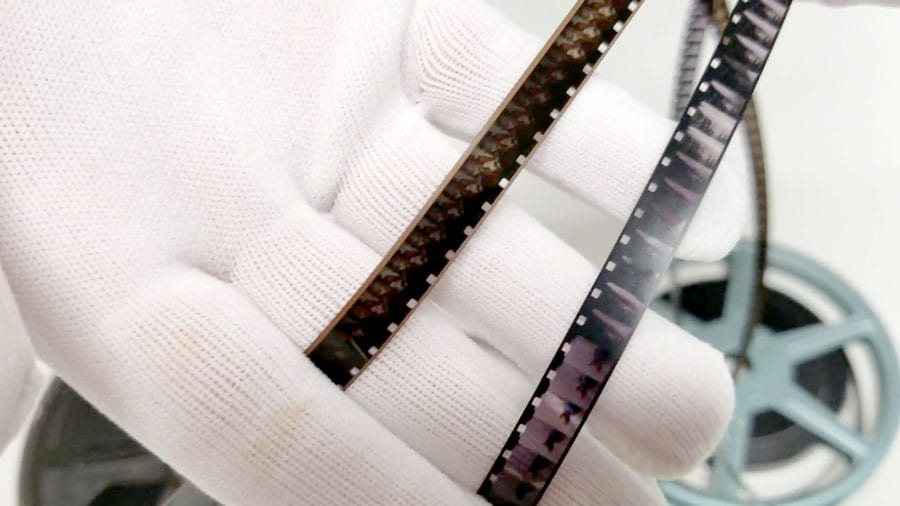EverPresent sees film of all ages and sizes. We convert 8mm, Super 8, 16mm, and other film reel formats into shareable digital videos.
Many clients try the viewing station at our Newton, MA store to relive their past for the first time in years. As our in-store viewer doesn’t play audio, clients who use it ask if we capture the sound from their film reels. So we want to get the word out there!
Magnetic Sound on Film – Do you have any?
Our experts can quickly figure out if your film reels have audio. Before you bring us your movies, here are some photos that make it easy for you to see whether your 16mm footage has sound too.



- For Regular 8 film reels, the audio is kept in a metal strip attached to the film. The strip often has a gold or rusty hue. It runs along the side of the film reel right next to the tiny square holes.
- For Super 8 film reels, sound is also stored on the same gold-colored band. Yet in addition to a thin strip of tape along the film’s holes, there is also a thick strip on the other side’s outer edge.
- 16mm film reels can have sound on them, too. Again, you should look for the rust-colored strip running along the edge of the film reel. This magnetic band stores the audio. Unlike standard 8mm film, the sound strip is on the opposite side of the holes.
- 16mm optical sound film:Film reels with optical sound show you a small, visual form of the sound waves. Another clear trait of these film reels is that you can see through them. If you have 16mm film with optical sound, it’s most likely a professional recording. This type of sound was not available on 8mm or Super8 film reels.

How to Measure Your Film Reels for Footage
If your home movies have audio, our film-to-digital transfer process can always capture it. But the bulk of our clients’ film reels are silent, so footage with sound is rare by comparison! Here’s a quick look at film’s quest to make some noise.
Sound on Film History

Motion pictures did not always have sound. In fact, nearly all movies were silent from the birth of film until the late 1920s. Feature films from what’s known as the ‘Silent Era’ relied on text, motion, and acting to tell tales without sound.
Lots of theaters played live or canned music at shows. Some films also came out with sound on a separate disc. Yet in most cases, sound systems were just too pricey for most venues. Some early film execs thought that investing in sound would not pay off, so they held off on movies with audio.
 You might have heard the phrase, ‘silence is deafening.’ It can feel strange to watch a home video when it’s missing a big piece of reality: audio! This issue was fixed in the late ’20s and early ’30s when Hollywood started releasing films with sound, or ‘talkies.’
You might have heard the phrase, ‘silence is deafening.’ It can feel strange to watch a home video when it’s missing a big piece of reality: audio! This issue was fixed in the late ’20s and early ’30s when Hollywood started releasing films with sound, or ‘talkies.’
Sound-on-film technology came out well before it hit the big screen. But it might have been too costly for home use until the 1970s. A 1973 Popular Mechanics article describes the Kodak Ektasound, a once-new type of Super 8 camera that shoots movies with audio.
If your vintage home movies do have sound, they probably come from the 1970s or later. Your silent film could be older than that, but it was still sold to consumers as a more affordable option during the rise of audio. If you’re not sure whether your old footage has sound, keep reading!
Listen up!
 The memories on your 8mm film reels are priceless, with or without sound. It’s nice to hear your home movies, but ‘talkies’ were too pricey for most folks until the ’70s.
The memories on your 8mm film reels are priceless, with or without sound. It’s nice to hear your home movies, but ‘talkies’ were too pricey for most folks until the ’70s.
If your items do have audio, we’d love to capture it. And don’t worry – if your footage is silent, EverPresent can add your choice of music to make your digital videos feel more natural.
This isn’t an end-all guide to spotting sound on every film reel. Yet these tips will help you to quickly tell if your reels have an audio piece. If you do have an odd film reel canister or something else we haven’t mentioned, it’s best to just give us a call. You can also snap a photo and email it to us with your question.

